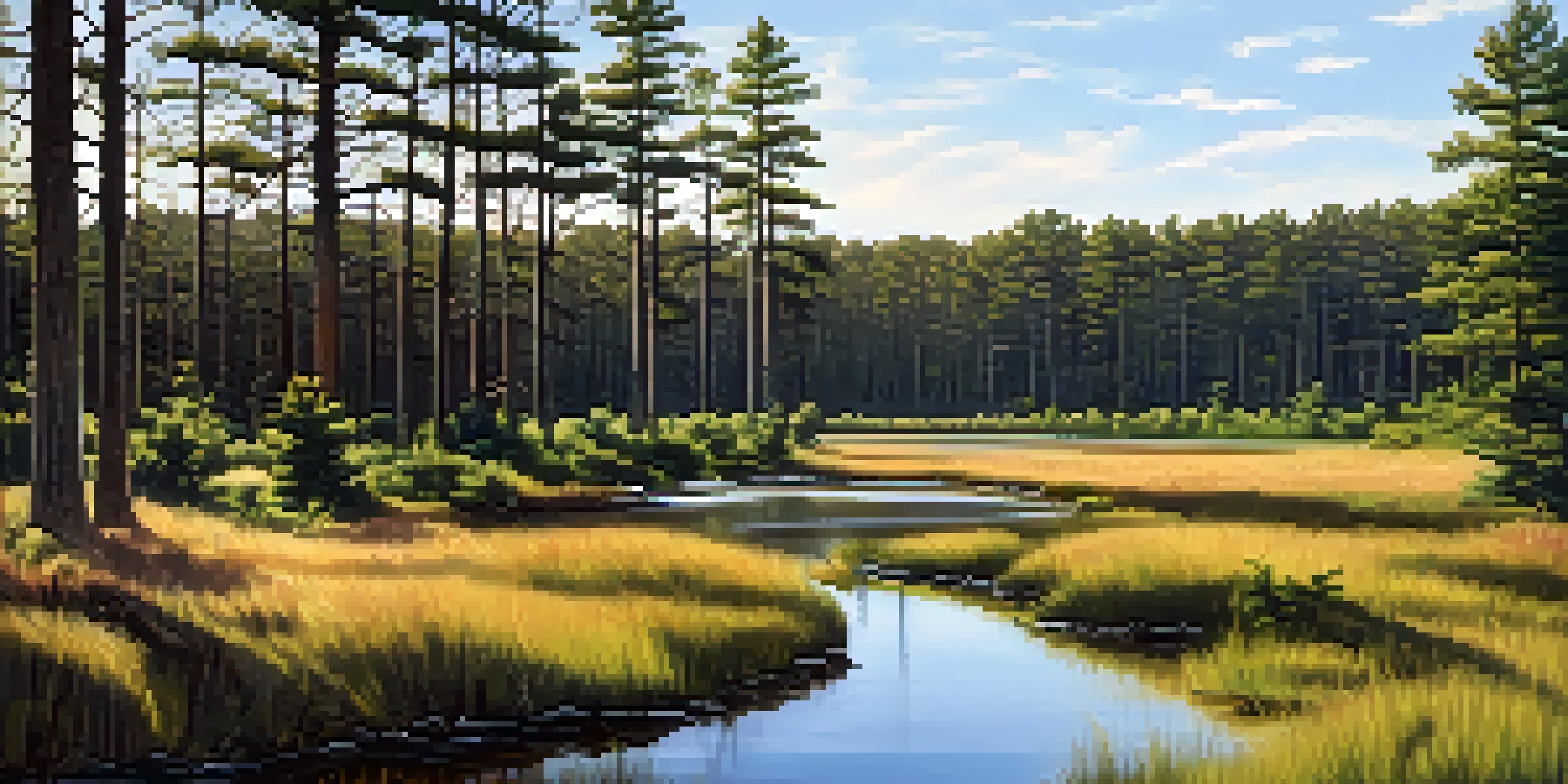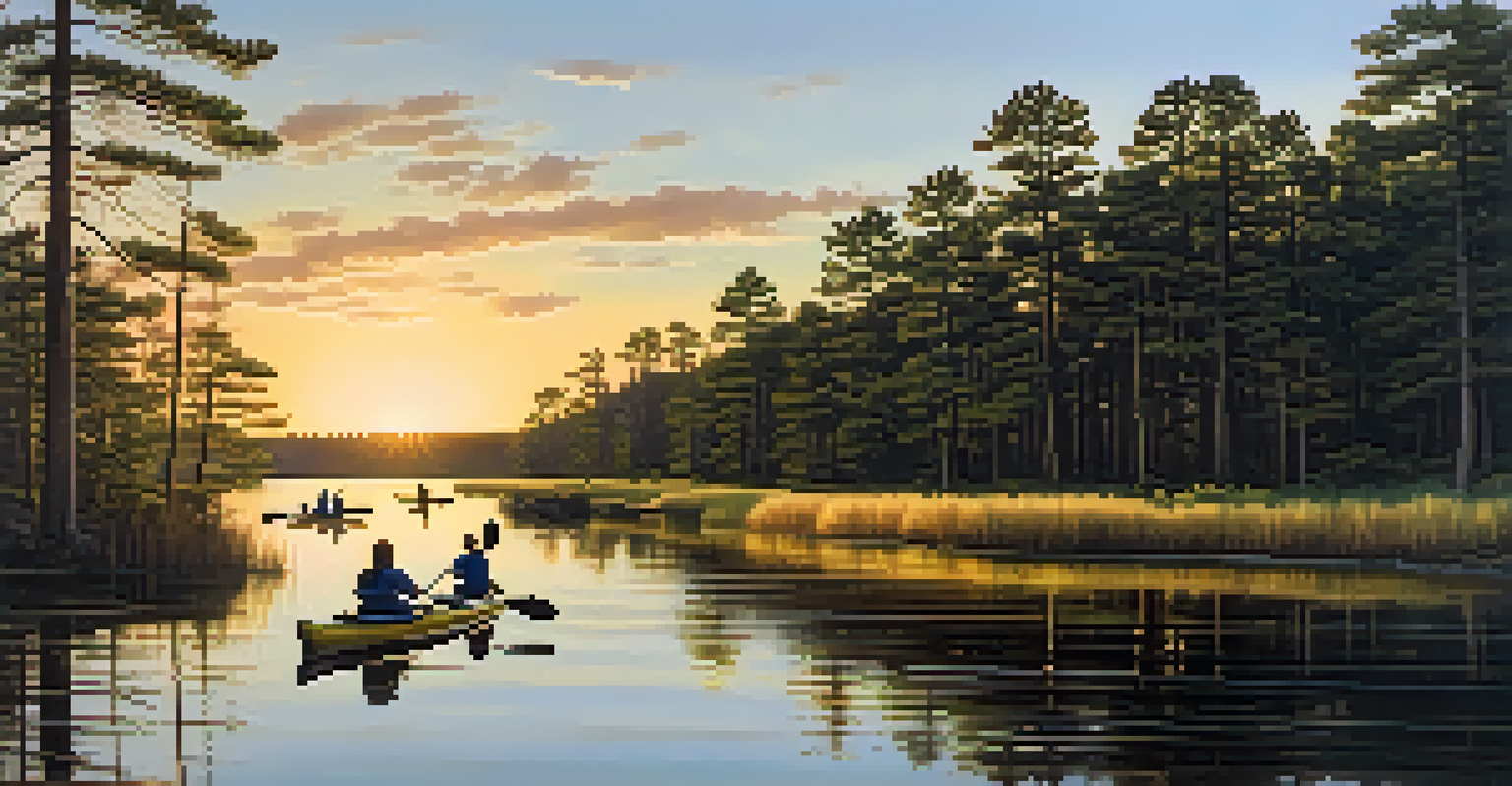The Pine Barrens: A Unique Ecological Region in New Jersey

An Overview of the Pine Barrens' Unique Ecosystem
The Pine Barrens, a sprawling ecosystem in New Jersey, is renowned for its rich biodiversity and distinctive landscapes. Covering over a million acres, this region is characterized by its sandy soils, pitch pine trees, and an array of wildlife. It's a place where nature thrives, offering a unique glimpse into the ecological diversity that exists just outside urban environments.
In every walk with nature one receives far more than he seeks.
Within the Pine Barrens, you'll find an impressive variety of plant and animal species, some of which are rare or endangered. The combination of wetlands, forests, and heathlands creates a mosaic of habitats that support everything from the elusive Pine Barrens tree frog to the majestic barred owl. This diversity not only makes the area biologically significant but also highlights the importance of conservation efforts.
Exploring the Pine Barrens is like stepping into a natural treasure chest. Each turn on a trail reveals unique flora and fauna, reminding visitors of the delicate balance in nature. It's a reminder of why preserving such unique ecosystems is crucial for future generations.
The History and Cultural Significance of the Pine Barrens
The history of the Pine Barrens is as rich as its ecology, with roots that trace back to the Native American tribes that first inhabited the area. These early inhabitants relied on the land for sustenance, utilizing its resources for food, shelter, and tools. The region's history is woven into the fabric of its landscape, creating a deep cultural significance that remains today.

As European settlers arrived, they began to transform the Pine Barrens, exploiting its natural resources for timber and agriculture. However, the harsh sandy soils made farming difficult, leading many to turn to the thriving industries of cranberry farming and glass manufacturing. This industrial past has left its mark, shaping both the economy and the community in the Pine Barrens.
Biodiversity in the Pine Barrens
The Pine Barrens is home to over 850 plant species and unique wildlife, making it a vital ecological region.
Today, the Pine Barrens not only serves as a reminder of New Jersey's history but also as a cultural symbol of conservation. Efforts to protect this unique region emphasize the importance of preserving heritage while fostering community pride and environmental stewardship.
Flora and Fauna: The Biodiversity of the Pine Barrens
One of the most captivating aspects of the Pine Barrens is its remarkable biodiversity. The region is home to over 850 plant species, including the iconic pitch pine and various types of oaks. These plants have adapted to the sandy soil and periodic wildfires, showcasing nature's resilience and ingenuity.
The environment is where we all meet; where we all have a mutual interest; it is the one thing all of us share.
In terms of wildlife, the Pine Barrens hosts a variety of species, some of which are endemic to the region. The Pine Barrens tree frog, for example, thrives in this unique habitat and is a key indicator of environmental health. Birdwatchers can delight in spotting species like the red-headed woodpecker and the eastern whip-poor-will, making the area a haven for nature enthusiasts.
The interplay between flora and fauna creates a vibrant ecosystem that supports life in many forms. Whether it's the delicate balance of predator and prey or the intricate relationships between plants and pollinators, the Pine Barrens serves as a living laboratory for ecological study and appreciation.
Recreational Opportunities in the Pine Barrens
For those seeking adventure, the Pine Barrens offers a myriad of recreational activities. Hiking, biking, and birdwatching are just a few ways to explore this expansive wilderness. With numerous trails winding through the forests and wetlands, visitors can immerse themselves in nature and experience the tranquility of the outdoors.
Kayaking and canoeing along the winding rivers, such as the Batsto and Wading, provide a unique perspective of the Pine Barrens. Paddlers can glide through serene waters surrounded by lush vegetation, encountering wildlife along the way. It's not uncommon to spot a heron or the occasional otter while enjoying a peaceful day on the water.
Cultural and Historical Significance
The Pine Barrens reflects a rich history intertwined with Native American heritage and early European settlement.
Whether you're an adrenaline junkie or someone looking for a peaceful retreat, the Pine Barrens has something to offer. Its diverse landscapes make it a perfect destination for outdoor enthusiasts of all skill levels, encouraging a deeper connection with nature.
The Role of Conservation in the Pine Barrens
Conservation efforts in the Pine Barrens are crucial to preserving its unique ecology for future generations. With increasing urban development and climate change, protecting this invaluable ecosystem has become a priority for environmental organizations and local governments. Initiatives aimed at habitat restoration and species protection help ensure the resilience of this region.
Community involvement plays a vital role in these conservation efforts. Local volunteers often participate in clean-up events, tree plantings, and educational programs to raise awareness about the importance of the Pine Barrens. This grassroots activism fosters a sense of ownership and responsibility among residents, creating a community dedicated to protecting its natural heritage.
As awareness grows about the ecological significance of the Pine Barrens, more people are inspired to contribute to its preservation. By combining scientific research with community engagement, these efforts aim to create a sustainable future for this unique ecological region.
Challenges Facing the Pine Barrens Ecosystem
Despite its beauty and ecological importance, the Pine Barrens faces several challenges that threaten its integrity. Urbanization, largely driven by population growth in New Jersey, has led to habitat fragmentation and pollution. These factors not only impact wildlife populations but also the overall health of the ecosystem.
Additionally, climate change poses a serious threat to the Pine Barrens. Altered precipitation patterns and increasing temperatures can disrupt the delicate balance of its habitats, affecting both plant and animal species. The region's unique sandy soils are particularly vulnerable, as they may not retain moisture needed for survival during prolonged droughts.
Conservation Efforts are Vital
Community involvement and conservation initiatives are essential to protect the Pine Barrens from urbanization and climate change.
Addressing these challenges requires a collaborative approach involving government agencies, environmental organizations, and the local community. By working together, it's possible to implement effective strategies that mitigate these threats and ensure the Pine Barrens remains a thriving ecosystem.
How to Visit and Explore the Pine Barrens
Visiting the Pine Barrens is an adventure waiting to happen, and getting there is easy. Located in southern New Jersey, the region is accessible from major highways and offers various entry points. Whether you're planning a day trip or a weekend getaway, there are plenty of resources available to help you plan your visit.
Once you arrive, consider stopping by one of the visitor centers to gather information on trails, maps, and local attractions. Many centers offer guided tours and educational programs that provide deeper insights into the Pine Barrens' ecology and history. Engaging with knowledgeable staff can enhance your experience and help you discover hidden gems within this vast landscape.

Remember to pack accordingly, as the Pine Barrens can be rugged and wild. Comfortable shoes, plenty of water, and a sense of adventure are all you need to enjoy exploring this unique ecological region. With its breathtaking views and diverse wildlife, the Pine Barrens promises an unforgettable experience for all who venture into its heart.